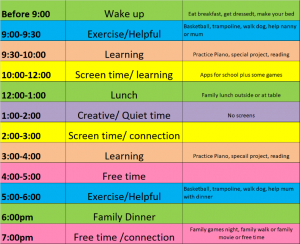Working from home with kids can be challenging, frustrating and unproductive. To help you and your teams we have put together the following step by step guide on how to create some structure to ensure you kids are entertained, to reduce the reliance on screen time, to ensure their mental health is nourished and to hopefully find some time for you to be productive.
We understand that kids have different needs depending on a range of factors including their age and their ability to entertain themselves so please use the following as a guide to put in place what will work for your family.
- First step is to sit down with your kids and explain that you want to put a system in place that gives them some clear boundaries on how they can spend their time each day. Explain this is important for them to have balance between active and inactive activity, rest and play but it is also important because you need to have dedicated work time when you are not disturbed.
- Decide on what types of activities you would like your children to do each day. This is important to ensure balance across the day and to meet the health and well-being needs of your child(ren). My list includes:

- Physical activity
- Helpful time
- Creative / quiet time
- Screen time
- Connection time
- School/ Learning/ special projects
This is particularly useful when you have a child like mine who would spend all day online playing Fortnite if left to their own devices…!
- Next, brainstorm with your children a range of activities that fall under these topics. This is an opportunity for your child to think about what they can do to entertain themselves. Think about age appropriate activities for your child(ren). I have an 11 and 14 year old so here is my example:
Physical activity:- Basketball drills
- Trampoline fitness jumping or Trampoline – make up a routine
- Walk the dog
- Home exercise program – make one up or use YouTube
Creative time or quiet time(No screen time & on your own)
- Read/ Guided meditation/
- Lego/ play with toys
- Craft activity (paint, draw, make & do)
Helpful
- Normal chores / Special chores (create chores list with points and aim to reach 100 points within a week to earn a special treat!)
- Meal support – Make your own breakfast/lunch
- Wipe down surfaces
- Look after animals
Screen time (Also known as favourite time!)
- Connect with friends online to chat
- Play games online with friends
- Watch TV/Movie (this could also come under quiet time if you are a nice parent! 😉)
- Play games online
- Scroll mindlessly through social media and tiktok!
Connection Time
- Family walk/ family dinner/ family board game
- Play a game with a sibling (stretch goal!)
- Call/facetime a relative to check in and connect
- Chat to friends over the phone/ online
School/ Learning/ Special Projects
- Lessons/study/ homework
- Music practice
- Reading
- Learn a new skill
- Work on a special project
 The next step will depend on how structure you want your child’s day to be. Option 1 is to create a blank daily timetable for your family (or ask your children to draw one). Add an activity type heading to each timeslot. This will guide your children as to what activity they should be doing each hour/half hour. I have broken mine up into 30-120min slots, depending on the activity type. This may vary for each child depending on age and attention span. Option 2 might work better for older kids who need less direction with some structure but plenty of space to make their own decisions. With this option explain to kids they need to ensure they do something from each activity type every day. Either option add some free time for older kids so they can then choose what they do during this time.
The next step will depend on how structure you want your child’s day to be. Option 1 is to create a blank daily timetable for your family (or ask your children to draw one). Add an activity type heading to each timeslot. This will guide your children as to what activity they should be doing each hour/half hour. I have broken mine up into 30-120min slots, depending on the activity type. This may vary for each child depending on age and attention span. Option 2 might work better for older kids who need less direction with some structure but plenty of space to make their own decisions. With this option explain to kids they need to ensure they do something from each activity type every day. Either option add some free time for older kids so they can then choose what they do during this time.- Explain to your children they should refer to the timetable to see what type of activity they should be doing then to refer to the list of activities they can choose from. Encourage them to add to this list each day as they think of new things.
- Trial and review – you may need to change the timeframes and or activities once you have trialled your timetable. You can also switch up the timetable headings every few days for variety or to meet your work needs.
Further Tips:- Smaller kids might require you to put specific activities in their timetable while older kids might prefer to choose their own. Teenagers might just need a simple timetable that requires them to leave their room every now and then…. i.e. exercise and do chores!
- For variety you can ask kids to choose different activities for each day. If you are super organised, you could create a whole weeks’ worth on one timetable
- Ensure activities that absolutely do not require your supervision are scheduled for when you have important work calls or online meetings. i.e. Quiet time is really good for this
- Where possible have meals together. This is an opportunity to break up the day and spend time connecting as a family. We also try and eat lunch outside – weather permitting.
- It is a little bit of work and negotiation to set up but will break up the long days ahead for your children, give them some structure and balance and hopefully, free you up.
- BE FLEXIBLE – this is just guide for your family, they won’t always stick to it!
Good luck and remember to stay calm and reach out if you need support
Power to Process are business consultants who support small and large businesses through transformation & change